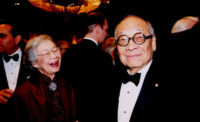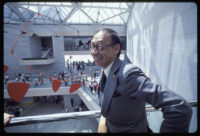I. M. Pei's Protégé Perry Chin Makes His Own Mark on the National Gallery's East Building

Photo © Matthew Bisanz

Architect Perry Chin
Photo courtesy Perry Chin


Perry Chin isn’t a well-known architect, but he is about to make his mark on a very well-known building. A confidant of I. M. Pei, who is 96, Chin was asked to consult on plans to give Pei’s East Building of the National Gallery in Washington new heating, cooling, security, and fire safety systems. The National Gallery had turned to Pei for advice on updating the building, which opened in 1978, and Pei recommended Chin.
“About two months into the exercise,” Chin, 62, recalls, “I was walking the building with the staff, looking for places for fire stairs, and discovered a gorgeous space that was unused.” In fact, there were two such spaces—hexagonal voids atop the building’s Pennsylvania Avenue-side towers. After learning that museum director Earl A. (Rusty) Powell was searching for more gallery space, Chin suggested using the tower rooms for exhibitions.
Soon, construction will begin on two new galleries, totaling about 12,000 square feet—as well as a sculpture terrace connecting the two rooms. (The architect of the renovation is Washington’s Hartman-Cox.) The $30 million cost of the new galleries was raised privately. Now the museum, which had already budgeted $38 million for the facilities upgrade, will have more to show for the three-year renovation than improved, but largely invisible, systems.
For Chin, who works out of his home in Dobbs Ferry, N.Y., the project represents a kind of full-circle moment. More than 30 years ago, after seeing the East Building in a magazine, Chin, who had recently graduated from architecture school in Illinois, wrote to Pei asking for a job. He was hired by the firm now known as Pei Cobb Freed and Partners, where he remained until 1995. For the next 14 years, he rented space at Pei Partnership Architects, in part to be near Pei.
The building’s galleries will close for three years, starting in January, but its atrium and administrative wing will remain open. In one significant change, a pair of circular stairs by Pei, which now stop at the second-floor galleries, will be replaced by diamond-shaped flights that will ascend to the new aeries, Chin says.
Meanwhile, the building’s exterior is in the final phases of a complex, $85 million reconstruction project that has, at times, left it looking more like a brick schoolhouse than the iconic Pei museum. That project began after pieces of the pink marble façade began coming loose, the result, the gallery says, of improper installation. “Materials left in the joints during construction resisted thermal movement and created unanticipated stresses on the panels’ anchors,” says Deborah Ziska, the museum’s chief of press and public information. According to Ziska, the façade repair has required the creation of just six new marble panels, out of the 17,026 removed and polished.
As for the interior, Chin says Pei was aware that there were residual spaces atop the tower galleries, and he initially expected the museum to use the extra headroom by raising the ceilings of the top-floor galleries for certain shows. That rarely happened, however, in part because moving the ceilings was a cumbersome job. Now, Chin says, the spaces will allow for intimate displays: “They’ll be like private rooms for art amid this very large museum.”








